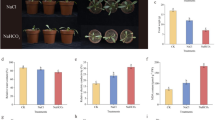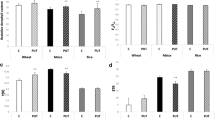Abstract
Pandanus odorifer L. belongs to Pandanaceae grows in the wild, mainly in semi-natural vegetation throughout the tropical and subtropical Pacific in littoral habitats, where it prevails against drought, strong winds, and salt sprays. To investigate the mechanism of salt stress tolerance in P. odorifer, the leaves from natural populations growing in the coastal region (SW) and those maintained under fresh water conditions (FW) were compared and analyzed for the common osmolytes proline, glycine betaine and γ-aminobutyric acid (GABA). The proline contents in both FW (13 µmol/g) and SW (12.7 µmol/g) plants were found nearly equal. The glycine betaine in FW plants was 0.745 µmol/g and in SW plants, it was 1.71 µmol/g and the amount of GABA in SW plants was ~60 and ~15 µmol/g in FW plants. Thus, among the three metabolites, GABA contents were found significantly higher, hence, the key enzymes responsible for GABA biosynthesis; glutamate decarboxylase (GAD EC 4.1.1.15), succinic semialdehyde dehydrogenase (SSADH EC 1.2.2.16) and betaine aldehyde dehydrogenase 2 (BADH2 EC 1.2.1.8) were studied with respect to their activity and expression levels in FW and SW plants. Relative expression of GAD was higher in both FW as well as in SW plants of P. odorifer. The highest activity and expression level of GAD under both the conditions suggests that probable pathway for GABA synthesis in P. odorifer is via GABA shunt.





Similar content being viewed by others
Abbreviations
- GABA:
-
γ-Aminobutyric acid
- GB:
-
Glycine betaine
- GAD:
-
Glutamate decarboxylase
- SSADH:
-
Succinic semialdehyde dehydrogenase
- BADH2:
-
Betaine aldehyde dehydrogenase2
- SSA:
-
Succinic semialdehyde
- GABald:
-
4-Aminobutyraldehyde
References
Nadaf AB, Zanan RL (2012) Indian Pandanaceae—an overview. Springer. doi:10.1007/978-81-322-0753-5, ISBN 978-81-322-0753-5
Chinnusamy V, Zhu JK (2009) Epigenetic regulation of stress responses in plants. Curr Opin Plant Biol 12:133–139. doi:10.1016/j.pbi.2008.12.006
Yancey PH (2005) Organic osmolytes as compatible, metabolic and counteracting cytoprotectants in high osmolarity and other stresses. J Exp Biol 208:2819–2830. doi:10.1242/jeb.01730
Suprasanna P, Nikalje GC, Rai AN (2016) Osmolyte accumulation and implications in plant abiotic stress tolerance. In: Iqbal N et al (eds) Osmolytes and plants acclimation to changing environment: emerging omics technologies. Springer, pp 1–12. doi: 10.1007/978-81-322-2616-1_1
Slama I, Abdelly C, Bouchereau A, Flowers T, Savouré A (2015) Diversity, distribution and roles of osmoprotective compounds accumulated in halophytes under abiotic stress. Ann Bot 115(3):433–447. doi:10.1093/aob/mcu239
Vicente O, Boscaiu M, Naranjo MÁ, Estrelles E, Bellés JM, Soriano P (2004) Responses to salt stress in the halophyte Plantago crassifolia (Plantaginaceae). J Arid Environ 58(4):463–481. doi:10.1016/j.jaridenv.2003.12.003
Muralitharan MS, Chandler S, Van SR (1992) Effects of NaCl and Na2SO4 on growth and solute composition of highbush blueberry (Vaccinium corymbosum). Funct Plant Biol 19(2):155–164. doi:10.1071/PP9920155
Akihiro T, Koike S, Tani R, Tominaga T, Watanabe S, Iijima Y, Aoki K, Shibata D, Ashihara H, Matsukura C, Akama K (2008) Biochemical mechanism on GABA accumulation during fruit development in tomato. Plant Cell Physiol 49(9):1378–1389. doi:10.1093/pcp/pcn113
Renault H, Roussel V, El Amrani A, Arzel M, Renault D, Bouchereau A, Deleu C (2010) The Arabidopsis pop2-1 mutant reveals the involvement of GABA transaminase in salt stress tolerance. BMC Plant Biol 10:20. doi:10.1186/1471-2229-10-20
Arakawa K, Katayama M, Takabe T (1990) Levels of betaine and betaine aldehyde dehydrogenase activity in the green leaves, and etiolated leaves and roots of barley. Plant Cell Physiol 31(6):797–803. doi:10.1093/oxfordjournals.pcp.a077981
Trossat C, Rathinasabapathi B, Hanson AD (1997) Transgenically expressed betaine aldehyde dehydrogenase efficiently catalyzes oxidation of dimethylsulfoniopropionaldehyde and [omega]-aminoaldehydes. Plant Physiol 113(4):1457–1461. doi:10.1104/pp.113.4.1457
Satya Narayan V, Nair PM (1989) Potato tuber succinate semialdehyde dehydrogenase: purification and characterization. Arch Biochem Biophys 275(2):469–477. doi:10.1016/0003-9861(89)90393-7
Kumar S, Punekar NS (1998) Inhibition of succinic semialdehyde dehydrogenase by N-formylglycine. J Enzyme Inhib 13:369–376. doi:10.3109/14756369809021482
Livak KJ, Schmittigen TD (2001) Analysis of relative gene expression data using real-time quantitative PCR and the 2(−delta delta C (T)) method. Methods 25:402–408. doi:10.1006/meth.2001.1262
Shelp BJ, Bown AW, McLean MD (1999) Metabolism and functions of gamma-aminobutyric acid. Trends Plant Sci 4(11):446–452. doi:10.1016/S1360-1385(99)01486-7
Bouche N, Fromm H (2004) GABA in plants: just a metabolite? Trends Plant Sci 9:110–115. doi:10.1016/j.tplants.2004.01.006
Satya Narayan V, Nair PM (1990) Metabolism, enzymology and possible roles of 4-aminobutyrate in higher plants. Phytochem 29:367–375. doi:10.1016/0031-9422(90)85081-P
Komatsuzaki N, Nakamura T, Kimura T, Shima J (2008) Characterization of glutamate decarboxylase from a high γ-aminobutyric acid (GABA)-producer, Lactobacillus paracasei. Biosci Biotechnol Biochem 72(2):278–285. doi:10.1271/bbb.70163
Matsumoto T, Yamaura I, Funatsu M (1986) Purification and properties of glutamate decarboxylase from squash. Agric Biol Chem 50(6):1413–1417. doi:10.1080/00021369.1986.10867591
Johnson BS, Singh NK, Cherry JH, Locy RD (1997) Purification and characterization of glutamate decarboxylase from cowpea. Phytochemistry 46(1):39–44. doi:10.1016/S0031-9422(97)00236-7
Zhang H, Yao HY, Chen F, Wang X (2007) Purification and characterization of glutamate decarboxylase from rice germ. Food Chem 101(4):1670–1676. doi:10.1016/j.foodchem.2006.04.027
Satya Narayan V, Nair PM (1985) Purification and characterization of glutamate decarboxylase from Solanum tuberosum. Eur J Biochem 1150(1):53–60. doi:10.1111/j.1432-1033.1985.tb08987.x
Chen TH, Murata N (2011) Glycinebetaine protects plants against abiotic stress: mechanisms and biotechnological applications. Plant Cell Environ 34:1–20. doi:10.1111/j.1365-3040.2010.02232.x
Murakeozy EP, Nagy Z, Duhaze C, Bouchereau A, Tuba Z (2003) Seasonal changes in the levels of compatible osmolytes in three halophytic species of inland saline vegetation in Hungary. J Plant Physiol 160:395–401. doi:10.1078/0176-1617-00790
Hibino T, Meng YL, Kawamitsu Y, Uehara N, Matsuda N, Tanaka Y, Ishikawa H, Baba S, Takabe T, Wada K, Ishii T, Takabe T (2001) Molecular cloning and functional characterization of two kinds of betaine-aldehyde dehydrogenase in betaine-accumulating mangrove Avicennia marina (Forsk.) Vierh. Plant Mol Biol 45:353–363. doi:10.1023/A:1006497113323
Shelp BJ, Bozzo GG, Trobacher CP, Chiu G, Bajwa VS (2012) Strategies and tools for studying the metabolism and function of γ-aminobutyrate in plants. I. Pathway structure. Botany 90(8):651–668. doi:10.1139/B2012-030
Bai Q, Chai M, Gu Z, Cao X, Li Y, Liu K (2009) Effects of components in culture medium on glutamate decarboxylase activity and γ-aminobutyric acid accumulation in foxtail millet (Setaria italica L.) during germination. Food Chem 116(1):152–157. doi:10.1016/j.foodchem.2009.02.022
Bradbury LM, Gillies SA, Brushett DJ, Waters DLE, Henry RJ (2008) Inactivation of an aminoaldehyde dehydrogenase is responsible for fragrance in rice. Plant Mol Biol 68:439–449. doi:10.1007/s11103-008-9381-x
Li QL, Gao XR, Yu XH, Wang XZ, Jiaan LJ (2003) Molecular cloning and characterization of betaine aldehyde dehydrogenase gene from Suaeda liaotungensis and its use in improved tolerance to salinity in transgenic tobacco. Biotechnol Lett 25:1431–1436. doi:10.1023/A:1025003628446
Livingstone JR, Maruo T, Yoshida I, Tarui Y, Hirooka K, Yamamoto Y, Tsutui N, Hirasawa E (2003) Purification and properties of betaine aldehyde dehydrogenase from Avena sativa. J Plant Res 116:133–140. doi:10.1007/s10265-003-0077-7
Zhang H, Yao HY, Chen F (2006) Accumulation of Gamma Aminobutyric acid in rice germ using protease. Biosci Biotechnol Biochem 70:1160–1165. doi:10.1271/bbb.70.1160
Busch KB, Fromm H (1999) Plant succinic semialdehyde dehydrogenase. Cloning, purification, localization in mitochondria, and regulation by adenine nucleotides. Plant Physiol 121:589–597. doi:10.1104/pp.121.2.589
Yin Y, Yang R, Guo Q, Gu Z (2014) NaCl stress and supplemental CaCl2 regulating GABA metabolism pathways in germinating soybean. Eur Food Res Technol 238:781–788. doi:10.1007/s00217-014-2156-5
Dhakal R, Bajpai VK, Baek KH (2012) Production of GABA (γ-aminobutyric acid) by microorganisms: a review. Braz J Microbiol 43:1230–1241. doi:10.1590/S1517-83822012000400001
Acknowledgements
First author thank University Grants Commission (UGC), New Delhi for the award of BSR fellowship. The authors also thank Dr. Trupti Kad and Dr. Rahul Zanan for their help and suggestions.
Author information
Authors and Affiliations
Corresponding author
Ethics declarations
Conflict of interest
The authors declare that they have no conflict of interest.
Additional information
Significance statement
Salt tolerance mechanism of P. odorifer has been explored for the first time in this study. GABA emerged as a prominent osmolyte conferring salt stress tolerance in P. odorifer.
Rights and permissions
About this article
Cite this article
Rashmi, D., Nadaf, A. Understanding the Mechanism of Salt Tolerance in Pandanus odorifer L.. Proc. Natl. Acad. Sci., India, Sect. B Biol. Sci. 88, 1557–1563 (2018). https://doi.org/10.1007/s40011-017-0900-x
Received:
Revised:
Accepted:
Published:
Issue Date:
DOI: https://doi.org/10.1007/s40011-017-0900-x




